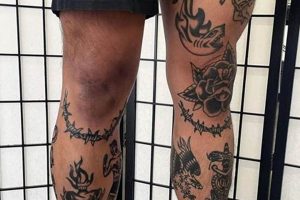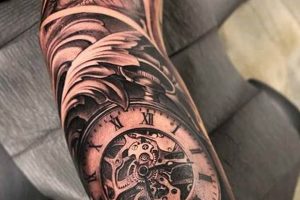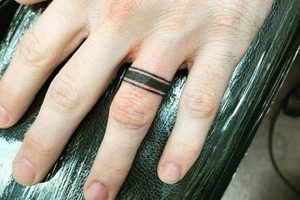Initial tattoo designs for the male demographic encompass a broad range of styles, imagery, and placements. Examples include small, symbolic designs like geometric shapes, minimalist line art, single words or short phrases, and representations of animals, nature, or cultural icons. Placement often focuses on areas that can be easily concealed or displayed as desired, such as the forearm, upper arm, chest, or back.
Choosing an appropriate initial design is crucial. It marks a significant personal milestone and serves as a permanent form of self-expression. A well-chosen design can reflect individual values, beliefs, passions, or commemorate important life events. Historically, tattoos have served various purposes across cultures, from signifying tribal affiliation and social status to acting as spiritual protection or artistic adornment. This rich history informs the diverse array of options available today.
The following sections will explore popular design themes, placement considerations, practical advice for the tattooing process, and aftercare guidelines. This information will assist individuals in making informed decisions about their inaugural tattoo experience.
Tips for Choosing an Initial Tattoo
Selecting a permanent design requires careful consideration. These tips offer guidance for navigating the process effectively.
Tip 1: Research Thoroughly. Explore various artists, styles, and designs before committing. Online galleries, social media, and local tattoo studios offer ample resources.
Tip 2: Consider Placement. Think about visibility, pain tolerance, and how the design might age on different body parts. Certain designs lend themselves better to specific locations.
Tip 3: Size Matters. A smaller design might be preferable for a first tattoo. This allows individuals to acclimate to the process and evaluate their desire for more extensive work later.
Tip 4: Reflect on Personal Meaning. Choose imagery or symbolism that resonates personally and holds long-term significance, avoiding fleeting trends.
Tip 5: Consult with a Professional Artist. Discuss ideas with a reputable tattoo artist to refine the design and ensure it aligns with their expertise and style.
Tip 6: Budget Appropriately. High-quality tattoos represent an investment. Factor cost into the decision-making process and avoid compromising quality for price.
Tip 7: Prioritize Aftercare. Proper aftercare is essential for healing and preserving the tattoo’s vibrancy. Follow the artist’s instructions diligently.
By following these guidelines, individuals can increase the likelihood of a positive and fulfilling first tattoo experience. A well-chosen design, applied by a skilled artist, becomes a meaningful and lasting piece of personal art.
This information equips individuals to embark on their tattoo journey with confidence and clarity.
1. Meaningful Symbolism
Meaningful symbolism plays a crucial role in initial tattoo choices, particularly for men. A tattoo acts as a permanent form of self-expression, often reflecting deeply held values, beliefs, experiences, or aspirations. The chosen symbolism imbues the tattoo with personal significance, transforming it from mere decoration into a powerful statement of identity.
For instance, a compass can symbolize a journey or direction in life. A lion can represent strength, courage, and leadership. Geometric patterns can evoke a sense of order, precision, and balance. Cultural or religious symbols connect individuals to their heritage and spirituality. Depictions of loved ones, whether portraits or symbolic representations, serve as lasting tributes. The selection of imagery should resonate deeply with the individual, ensuring long-term satisfaction and avoiding regret.
Consideration of meaningful symbolism offers several practical advantages. It facilitates a more informed decision-making process, guiding the individual towards designs that align with their core values. This reduces the likelihood of impulsive choices and increases the chances of obtaining a tattoo that remains relevant and meaningful throughout life. Careful selection of symbolic imagery ensures that the tattoo serves as a source of personal pride and a genuine reflection of self. This deepens the connection between the individual and their body art, further emphasizing the importance of symbolism in the initial tattoo selection process.
2. Appropriate Placement
Appropriate placement constitutes a critical factor in initial tattoo decisions for men. Placement impacts visibility, pain levels, and how the tattoo interacts with the body’s contours. Careful consideration of placement ensures the design complements the individual’s physique and aligns with their desired level of discretion.
- Visibility and Discretion
Visibility plays a significant role in placement choices. Individuals seeking easily concealed tattoos might opt for areas like the upper arm, back, or chest. These locations allow for discretion in professional or formal settings. Conversely, those comfortable with more visible tattoos may choose the forearm, wrist, or even the hand. Placement decisions should reflect individual preferences regarding visibility and social context.
- Pain Tolerance
Pain tolerance varies significantly among individuals and across different body areas. Areas with thinner skin or closer proximity to bone, such as ribs, ankles, or elbows, tend to be more sensitive. Individuals with lower pain thresholds might prefer fleshier areas like the thigh, outer arm, or shoulder. Researching pain levels associated with different placements allows for informed decision-making and a more comfortable tattooing experience.
- Body Contours and Design Flow
The body’s natural contours influence how a tattoo appears and ages. Skilled tattoo artists consider these contours when designing and placing tattoos. Certain designs lend themselves well to specific body parts. For example, a long, flowing design might work well on the forearm or calf, while a compact design might suit the shoulder blade or chest. Careful consideration of body contours ensures the tattoo complements the individual’s physique and enhances the design’s overall aesthetic.
- Long-Term Considerations
Placement also affects how a tattoo ages over time. Areas prone to stretching or sun exposure, such as the stomach or lower back, might experience greater changes in the tattoo’s appearance. Choosing a placement less susceptible to these changes can help preserve the tattoo’s integrity over the long term. Considering potential lifestyle changes, such as weight fluctuations or career choices, also informs placement decisions, ensuring the tattoo remains suitable and aesthetically pleasing throughout life.
Ultimately, appropriate placement maximizes the aesthetic impact of the tattoo while aligning with individual preferences and lifestyle. By considering these factors, individuals can achieve a cohesive and personally satisfying result that enhances their overall appearance and reflects their individual style. This integration of placement considerations into the initial design process highlights the importance of planning and foresight in achieving a successful and enduring tattoo.
3. Manageable Size
Manageable size represents a crucial consideration for initial tattoos, especially for men. Opting for a smaller design offers several practical advantages, allowing individuals to acclimate to the tattooing process and evaluate their desire for more extensive work later. A smaller tattoo also presents fewer logistical challenges regarding placement, healing, and potential future additions or modifications.
A smaller initial tattoo allows individuals to experience the process with a lower level of commitment. This is particularly beneficial for those uncertain about pain tolerance or long-term aesthetic preferences. A small design provides a manageable introduction to the sensation of tattooing and the healing process, allowing individuals to gauge their comfort levels before committing to larger, more complex pieces. For example, a small geometric design on the wrist or a simple band around the bicep offers a less daunting starting point than a full sleeve or back piece. This approach allows individuals to build confidence and make informed decisions about future tattoos.
Furthermore, smaller tattoos often present more flexibility in terms of placement and future design integration. They can be easily incorporated into larger pieces later or stand alone as minimalist statements. This adaptability offers a significant advantage for those who anticipate expanding their tattoo collection over time. A small initial tattoo can serve as a foundation for a larger, more intricate design, or it can remain a discrete, standalone piece. This flexibility minimizes the risk of regret and allows for a more curated and cohesive approach to body art. Understanding the importance of manageable size empowers individuals to approach their first tattoo experience with greater confidence and foresight.
4. Timeless Design
Timeless design represents a critical aspect of initial tattoo choices for men. Selecting a design that transcends fleeting trends ensures long-term satisfaction and prevents premature obsolescence of the chosen artwork. Timeless designs draw inspiration from classic imagery, enduring symbolism, and artistic styles that have maintained relevance throughout history. This approach prioritizes enduring aesthetics over ephemeral fashions, resulting in a tattoo that remains visually appealing and personally meaningful for years to come.
- Classic Imagery
Classic imagery encompasses motifs and symbols that have held cultural significance for generations. Examples include anchors, skulls, compasses, and various animal representations. These images possess inherent symbolic weight and resonate across cultures and time periods. Their enduring appeal makes them ideal choices for first tattoos, ensuring the design remains relevant and aesthetically pleasing regardless of evolving trends. An anchor, for instance, might symbolize stability and resilience, while a skull can represent mortality or overcoming challenges. These classic images carry inherent meaning and add a layer of depth to the tattoo.
- Geometric Patterns
Geometric patterns offer a timeless aesthetic quality due to their inherent order and symmetry. From simple lines and shapes to complex mandalas and tessellations, geometric designs offer a visually striking and enduring appeal. They can be adapted to various sizes and placements, making them versatile choices for initial tattoos. Furthermore, geometric patterns can be imbued with personal meaning through the specific shapes and configurations chosen. For example, a series of interconnected lines might represent interconnectedness or the journey of life, while a spiral could symbolize growth and transformation. This combination of aesthetic appeal and symbolic potential makes geometric patterns a compelling option for timeless tattoo designs.
- Traditional Styles
Traditional tattoo styles, such as American Traditional, Japanese, or Polynesian, have stood the test of time due to their bold lines, vibrant colors, and iconic imagery. These styles possess a rich history and cultural significance, lending an air of authenticity and permanence to the chosen design. While individual interpretations and artistic variations exist within these styles, their core elements remain consistent, ensuring a timeless quality. A traditional rose, for instance, symbolizes love and beauty, while a traditional eagle represents strength and freedom. These established meanings contribute to the enduring appeal of traditional tattoo styles.
- Minimalist Approach
Minimalist tattoos, characterized by their simplicity and clean lines, offer a timeless aesthetic that avoids the risk of appearing dated. These designs often feature small, uncluttered imagery, single words, or short phrases, focusing on impactful simplicity rather than intricate detail. This minimalist approach emphasizes the essential elements of the design, creating a timeless quality that transcends fleeting trends. A small, single-line drawing of a mountain range, for instance, can represent resilience and a love of nature without relying on intricate detailing. This understated approach contributes to the tattoo’s timeless appeal.
By embracing timeless design principles, individuals selecting their initial tattoo can ensure a piece of body art that remains aesthetically pleasing and personally meaningful for years to come. These designs transcend fleeting trends, focusing on enduring symbolism, classic imagery, and established artistic styles. This approach minimizes the risk of regret and ensures the tattoo remains a source of pride and self-expression throughout life. A timeless design represents an investment in personal style and a commitment to a piece of art that will endure through changing fashions and personal evolutions.
5. Skilled Artist Selection
Skilled artist selection represents a crucial element within the process of choosing a first tattoo. A skilled artist possesses the technical expertise and artistic sensibility to translate initial concepts into well-executed, lasting pieces of body art. This expertise significantly impacts the final result, influencing the tattoo’s aesthetic quality, longevity, and overall impact. The connection between skilled artist selection and first tattoo ideas lies in the artist’s ability to guide individuals through the design process, offering technical advice, stylistic recommendations, and practical considerations based on experience. For example, an experienced artist can advise on appropriate placement, size, and color palettes based on the individual’s skin tone, body type, and desired aesthetic.
The importance of skilled artist selection is further amplified by the permanent nature of tattoos. A poorly executed tattoo can lead to dissatisfaction, requiring costly and time-consuming removal or cover-up procedures. A skilled artist, conversely, ensures the initial design is rendered with precision and artistry, minimizing the risk of regret and maximizing long-term satisfaction. Real-life examples abound, demonstrating the consequences of choosing an inexperienced or unskilled artist. Faded ink, blurred lines, and uneven application are common outcomes of inadequate artistry. These issues can detract significantly from the tattoo’s aesthetic appeal and necessitate corrective work. Conversely, a skilled artist produces clean lines, vibrant colors, and a well-defined design that stands the test of time. A portfolio showcasing consistent high-quality work serves as a testament to an artist’s skill and dedication.
The practical significance of understanding this connection cannot be overstated. Investing time and effort in researching and selecting a skilled artist constitutes a crucial step in the first tattoo process. This careful selection ensures the initial design concept is translated into a high-quality, lasting piece of body art that meets the individual’s expectations and reflects their personal style. Thorough research, including reviewing online portfolios, seeking recommendations, and consulting with potential artists, empowers individuals to make informed decisions and avoid the pitfalls of unskilled artistry. Ultimately, skilled artist selection represents an investment in the quality and longevity of the tattoo, ensuring a positive and fulfilling first tattoo experience.
6. Thorough Aftercare
Thorough aftercare constitutes a critical component of successful first tattoo experiences for men, directly impacting the final healed result and long-term preservation of the chosen design. This crucial phase, often overlooked, plays a pivotal role in preventing complications, promoting proper healing, and maintaining the tattoo’s vibrancy and clarity. Understanding the connection between thorough aftercare and initial tattoo choices lies in recognizing that even the most expertly executed design can be compromised by inadequate post-tattoo care. This connection emphasizes the importance of aftercare as an integral part of the entire tattoo process, not merely an afterthought.
The impact of diligent aftercare manifests in several key ways. Proper cleaning and moisturizing prevent infection and promote healthy skin regeneration. Protecting the tattoo from excessive sun exposure minimizes fading and preserves color saturation. Avoiding harsh chemicals or abrasive materials during the healing process prevents irritation and scarring. These practices, often outlined by the tattoo artist, contribute significantly to the long-term aesthetic appeal and longevity of the tattoo. Neglecting these practices can lead to undesirable outcomes. Infections can cause discoloration, blurring of lines, and even permanent skin damage. Excessive sun exposure can fade ink, diminishing the vibrancy and clarity of the design. Picking or scratching the tattoo during healing can lead to scarring and distort the original artwork. Real-life examples demonstrate these consequences: a vibrant, detailed tattoo can become dull and indistinct due to sun damage, or a clean, crisp line can become blurred and uneven due to improper healing or infection.
The practical significance of understanding this connection is paramount. Thorough aftercare ensures the initial investment in design and artistry yields a lasting, high-quality result. By following the artist’s aftercare instructions diligently, individuals maximize the chances of their tattoo healing properly and retaining its intended appearance over time. This commitment to aftercare demonstrates respect for the artistry and a dedication to preserving the integrity of the chosen design. Integrating thorough aftercare into the initial planning stages of a first tattoo ensures individuals approach the entire process with a comprehensive understanding of its requirements and long-term implications. This proactive approach minimizes potential complications and maximizes the likelihood of achieving a visually appealing and enduring piece of body art.
Frequently Asked Questions
This section addresses common inquiries regarding initial tattoo choices for men, providing concise and informative responses to facilitate informed decision-making.
Question 1: How does one determine appropriate tattoo size?
Appropriate size depends on several factors, including desired placement, design complexity, and individual comfort level. Smaller designs are often recommended for initial tattoos, allowing acclimation to the process. Larger, more intricate pieces can be considered later.
Question 2: What factors influence tattoo cost?
Cost depends on size, complexity, artist’s experience, and studio location. High-quality work typically requires a greater investment. It’s advisable to discuss budget constraints with the chosen artist upfront.
Question 3: How is pain tolerance managed during tattoo application?
Pain tolerance varies among individuals and by body area. Over-the-counter pain relievers may be used, but consulting a physician beforehand is recommended. Numbing creams can sometimes be applied, but their efficacy varies.
Question 4: How long does the healing process typically take?
Healing typically takes several weeks, depending on size, placement, and individual healing rates. Following aftercare instructions diligently is essential for proper and timely healing.
Question 5: What are common signs of infection?
Common infection signs include excessive redness, swelling, prolonged pain, pus, or fever. Consulting a physician immediately upon suspecting infection is crucial.
Question 6: How does one choose a reputable tattoo artist?
Choosing a reputable artist involves researching portfolios, seeking recommendations, and scheduling consultations. Verifying proper licensing and adherence to hygiene standards is essential. A strong portfolio demonstrating consistent, high-quality work is a key indicator of a reputable artist.
Careful consideration of these frequently asked questions empowers individuals to approach their first tattoo experience with greater knowledge and confidence. Understanding these aspects contributes to a positive outcome and a lasting piece of body art.
Further research and consultation with experienced professionals can provide additional guidance throughout the tattoo selection and application process.
Conclusion
Exploration of initial tattoo designs for men reveals the importance of thoughtful consideration regarding symbolism, placement, size, design permanence, artist selection, and aftercare. Each element contributes significantly to a successful outcome, ensuring a meaningful and enduring piece of body art. Prioritizing timeless designs over fleeting trends ensures long-term satisfaction, while selecting a skilled artist guarantees professional execution and minimizes potential complications. Diligent aftercare preserves the tattoo’s integrity, protecting the investment of time, resources, and personal expression.
A well-chosen and expertly executed initial tattoo represents a significant personal milestone, serving as a permanent form of self-expression and a testament to individual style. Careful consideration of these key elements empowers individuals to embark on their tattoo journey with confidence and clarity, resulting in a piece of body art that resonates with personal meaning and endures through time.







